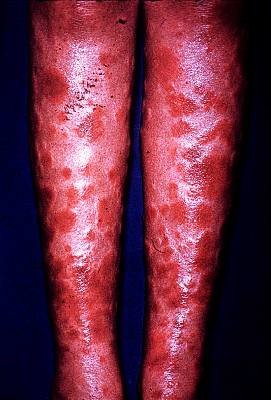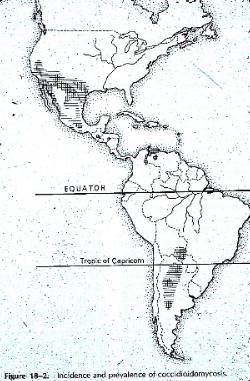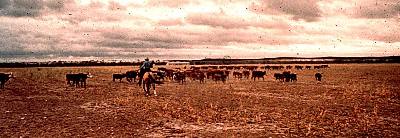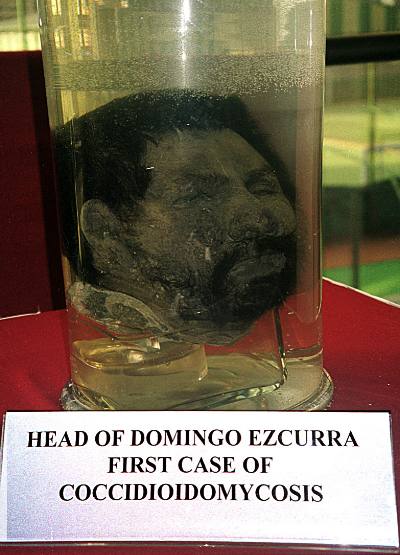Tom Volk's Fungus of the Month for January 2002
This month's fungus is Coccidioides immitis, cause of the fungal disease coccidioidomycosis, aka Valley Fever, San Joaquin Valley Fever, desert bumps, desert rheumatism or Posadas' disease
 Coccidioides immitis (kok-sid-ee-OID-eez IMM-ih-tiss) is the cause of a nasty fungal disease called coccidioidomycosis (kok-sid-ee-oid-oh-my-KOH-sis). Like the other true-pathogenic, systemic human fungal diseases histoplasmosis, blastomycosis, and paracoccidioidomycosis, Coccidioidomycosis starts out as a lung disease caused by inhalation of the conidia, shown to the left. Most often the disease causes mild flu-like symptoms, but usually is resolved in the lungs.
Coccidioides immitis (kok-sid-ee-OID-eez IMM-ih-tiss) is the cause of a nasty fungal disease called coccidioidomycosis (kok-sid-ee-oid-oh-my-KOH-sis). Like the other true-pathogenic, systemic human fungal diseases histoplasmosis, blastomycosis, and paracoccidioidomycosis, Coccidioidomycosis starts out as a lung disease caused by inhalation of the conidia, shown to the left. Most often the disease causes mild flu-like symptoms, but usually is resolved in the lungs.  This fungus is a dimorphic pathogen, which means it can change from the room-temperature hyphal form at to the body-temperature spherule form (shown to the right) containing endospores. These endospores can be transported by the bloodstream to other parts of the body, particularly to the brain and central nervous system, where they can germinate and grow to cause even more severe disease. The dimorphism helps the fungus to evade the immune system by the changing of the surface antigens of the fungus.
This fungus is a dimorphic pathogen, which means it can change from the room-temperature hyphal form at to the body-temperature spherule form (shown to the right) containing endospores. These endospores can be transported by the bloodstream to other parts of the body, particularly to the brain and central nervous system, where they can germinate and grow to cause even more severe disease. The dimorphism helps the fungus to evade the immune system by the changing of the surface antigens of the fungus.  The disease often begins as a benign, inapparent or mildly severe upper respiratory infection that usually resolves rapidly. Recovery from mild forms of the disease usually results in lifelong immunity to reinfection. However, if there are enough spores inhaled, or if the person's immune system is compromised in some way, the disease can spread to other parts of the body, Rarely the disease is an acute or chronic severe disseminating fatal mycosis. If infection is established, the disease may progress as a chronic pulmonary condition or as a systemic disease involving the meninges (lining of the brain), bones, joints, and subcutaneous and cutaneous tissues. Such involvement is characterized by the formation of burrowing abscesses. Although the symptoms of the disease are quite variable, but often the patient has an allergic reaction to the circulating fungus, producing reddening of the skin known as "desert bumps," shown to the left.
The disease often begins as a benign, inapparent or mildly severe upper respiratory infection that usually resolves rapidly. Recovery from mild forms of the disease usually results in lifelong immunity to reinfection. However, if there are enough spores inhaled, or if the person's immune system is compromised in some way, the disease can spread to other parts of the body, Rarely the disease is an acute or chronic severe disseminating fatal mycosis. If infection is established, the disease may progress as a chronic pulmonary condition or as a systemic disease involving the meninges (lining of the brain), bones, joints, and subcutaneous and cutaneous tissues. Such involvement is characterized by the formation of burrowing abscesses. Although the symptoms of the disease are quite variable, but often the patient has an allergic reaction to the circulating fungus, producing reddening of the skin known as "desert bumps," shown to the left. In culture the extremely small arthroconidia are produced on medium in 5-10 days. The mechanism of spore formation is quite different than what you might be used to. Thallic conidiation (formation of spores from pre-formed hyphae) takes place here. Alternate cells increase in turgidity and in wall thickness to become arthroconidia, while the intervening cells gradually lose cytoplasm. Nuclei remain in the degenerating cells until the adjacent spores completely mature. Arthroconidia are barrel or cask shaped, 2-4 mm X 6 mm, although there may be atypical isolates with different shapes. The spherules cannot normally be induced in culture, but require inhalation into an animal. These spherules bear a superficial resemblance to a chicken protozoan parasite Coccidia; Coccidioides literally means "like Coccidia" and immitis means "not mild." Incidentally, the other type of conidiation, far more common, is blastic conidiation. In this type, the spores are produced de novo from the budding out of hyphal tips. See this page on Aspergillus for an example of blastic conidiation. The teleomorph (sexual state, meiotically-reproducing state) of Coccidioides is unknown. The anamorph (asexual state, mitotically-reproducing state) has some characteristics of Zygomycota (spherule development is like sporangium development), except that it is regularly septate, has Woronin bodies near the septa, characteristic of Ascomycota and deuteromycetes. Analysis of 18S rDNA sequence indicates a close phylogenetic relationship of C. immitis and the Ascomycota, especially with the Arthrodermataceae (Onygenales), such as Ajellomyces dermatitidis and A. capsulatus. If this is true, then essentially all the true systemic pathogenic fungi, as well as the dermatophytes, would be classified in that small group of Ascomycota.
 Coccidioides is probably the most virulent of the fungal pathogens. Highly endemic disease areas are semi-arid regions, rather than completely dry. Its occurrence correlates well with the Lower Sonoran Life Zone, which occurs in desert-like areas throughout the southwestern USA and California, as well as into Mexico and Central and South America. It is prevalent in areas that receive rainfall of about 10 inches (25cm) /year occurring all in one season. The west side of the San Joaquin Valley in California is the most endemic area, but even within this region the fungus is highly restricted to a few small areas. However, spores may blow around-- for example a windstorm in 1977 in the San Joaquin Valley blew spores outside endemic area, and 379 new cases of coccidioidomycosis were attributed to the dust storm. Travel can also spread disease. The main problem is with population growth in endemic areas. People not previously exposed move to the area and develop the disease. Some have mild form and acquire immunity; others develop severe disease.
Coccidioides is probably the most virulent of the fungal pathogens. Highly endemic disease areas are semi-arid regions, rather than completely dry. Its occurrence correlates well with the Lower Sonoran Life Zone, which occurs in desert-like areas throughout the southwestern USA and California, as well as into Mexico and Central and South America. It is prevalent in areas that receive rainfall of about 10 inches (25cm) /year occurring all in one season. The west side of the San Joaquin Valley in California is the most endemic area, but even within this region the fungus is highly restricted to a few small areas. However, spores may blow around-- for example a windstorm in 1977 in the San Joaquin Valley blew spores outside endemic area, and 379 new cases of coccidioidomycosis were attributed to the dust storm. Travel can also spread disease. The main problem is with population growth in endemic areas. People not previously exposed move to the area and develop the disease. Some have mild form and acquire immunity; others develop severe disease. The fungus can survive at 20 cm under the soil, but is absent on the surface during hot dry weather. It is also apparently absent from the soil or aerosol during wet winter and spring, but grows again in the summer and becomes aerosolized in late summer and fall. Sept-Nov. is peak endemic period. The favored soils are alkaline, have a high content of carbonized organic materials and a high salt concentration, particularly calcium sulfate and borates. The sterile surface is reinvaded after the rainy season, possibly when capillary action of evaporation reestablishes a favorable salt concentration. Survival of the organism also occurs in rodent burrows. Rodents may become infected also and may be responsible for spreading the organism.
 Occupational hazards are in those occupations in the exposure to soil dust, including agricultural workers, construction workers, telephone pole diggers, and archaeological students. Dark-skinned individuals seem to be more prone to severe infection than Caucasians. AIDS cases limited by geography. Person to person transmission documented in only 5 cases-- 3 were premature infants, one was embalmer who accidentally pricked self while working on a person who had died of the disease. The other case was 6 medical staff members who inhaled arthrospores of Coccidioides growing on a plaster cast of a patient with coccidioidal ostemyelitis. There is a Coccidioides skin test, very similar to the tuberculosis skin test. The test shows that most people in endemic areas have come into contact with the organism. A small fever is usually the only symptom. Most people don't know they have had it. Thus the skin test is of limited diagnostic value since most people in endemic areas will test positive. The disease must be diagnosed from tissue material-- spherules with endospores must be found for an accurate diagnosis. The disease is notoriously difficult to diagnose-- the expert on this fungus Charles E. Smith wrote in "Reminiscences of the Flying Chlamydospore" that he had misdiagnosed his wife's, his son's and *his own* case of coccidioidomycosis. The limerick at the beginning of this page has been attributed to him. Since this is the most virulent of the fungal pathogens, it should never be grown out in culture except under very controlled conditions, such as using gloved transfer hood and in screw cap vials. The fungus produces its small arthrospores in abundance in culture. If these escape, they can cause lab infections. These arthrospores can pass through a 2 mm filter found in normal biological safety cabinets/ hoods! It is a very dangerous organism. There have been persistent rumors that it is being developed for use in biological warfare, but it could probably not be grown in a large enough quantity to be used for use in bioterrorism because of the danger it would pose for the people growing it. Some treatments for systemic coccidioidomycosis include Amphoteracin B or the azoles ketoconazole or itraconazole. Fungal diseases are notoriously difficult to treat because it is difficult to find drugs that kill the fungus without killing the human or animal host. Remember than animals and fungi are rather closely related and have much physiology in common since they are both eukaryotic. It's relatively easy to find ways to kill bacteria causing infections because bacteria are prokaryotic and there are many physiological differences that can be exploited.
Occupational hazards are in those occupations in the exposure to soil dust, including agricultural workers, construction workers, telephone pole diggers, and archaeological students. Dark-skinned individuals seem to be more prone to severe infection than Caucasians. AIDS cases limited by geography. Person to person transmission documented in only 5 cases-- 3 were premature infants, one was embalmer who accidentally pricked self while working on a person who had died of the disease. The other case was 6 medical staff members who inhaled arthrospores of Coccidioides growing on a plaster cast of a patient with coccidioidal ostemyelitis. There is a Coccidioides skin test, very similar to the tuberculosis skin test. The test shows that most people in endemic areas have come into contact with the organism. A small fever is usually the only symptom. Most people don't know they have had it. Thus the skin test is of limited diagnostic value since most people in endemic areas will test positive. The disease must be diagnosed from tissue material-- spherules with endospores must be found for an accurate diagnosis. The disease is notoriously difficult to diagnose-- the expert on this fungus Charles E. Smith wrote in "Reminiscences of the Flying Chlamydospore" that he had misdiagnosed his wife's, his son's and *his own* case of coccidioidomycosis. The limerick at the beginning of this page has been attributed to him. Since this is the most virulent of the fungal pathogens, it should never be grown out in culture except under very controlled conditions, such as using gloved transfer hood and in screw cap vials. The fungus produces its small arthrospores in abundance in culture. If these escape, they can cause lab infections. These arthrospores can pass through a 2 mm filter found in normal biological safety cabinets/ hoods! It is a very dangerous organism. There have been persistent rumors that it is being developed for use in biological warfare, but it could probably not be grown in a large enough quantity to be used for use in bioterrorism because of the danger it would pose for the people growing it. Some treatments for systemic coccidioidomycosis include Amphoteracin B or the azoles ketoconazole or itraconazole. Fungal diseases are notoriously difficult to treat because it is difficult to find drugs that kill the fungus without killing the human or animal host. Remember than animals and fungi are rather closely related and have much physiology in common since they are both eukaryotic. It's relatively easy to find ways to kill bacteria causing infections because bacteria are prokaryotic and there are many physiological differences that can be exploited.  Coccidioidomycosis was discovered by Alejandro Posadas in 1891 in a hospital in Buenos Aries, Argentina. He had a patient named Domingo Ezcurra who had the disease, and Posadas was able to study the progression of the disease over the course of seven years. Although the disease was discovered in Argentina, the second case was not found until 35 years later, and fewer than 30 cases were reported there before 1967. Interestingly, the preserved mortal remains of Domingo Ezcurra were found in 1948 in the anatomy museum of the medical school. His head is now the showpiece of the medical school museum and has been exhibited at medical mycology meetings in South America. In fact this picture was taken at such a meeting by Pat Kammeyer of the Loyola University of Chicago.
Coccidioidomycosis was discovered by Alejandro Posadas in 1891 in a hospital in Buenos Aries, Argentina. He had a patient named Domingo Ezcurra who had the disease, and Posadas was able to study the progression of the disease over the course of seven years. Although the disease was discovered in Argentina, the second case was not found until 35 years later, and fewer than 30 cases were reported there before 1967. Interestingly, the preserved mortal remains of Domingo Ezcurra were found in 1948 in the anatomy museum of the medical school. His head is now the showpiece of the medical school museum and has been exhibited at medical mycology meetings in South America. In fact this picture was taken at such a meeting by Pat Kammeyer of the Loyola University of Chicago. There is some recent work on Coccidioides by John Taylor and his associates at the University of California- Berkeley. They have DNA evidence that there are in fact two species of Coccidioides. One, still to be called Coccidioides immitis, appears to be restricted to California. Specimens found outside of California appear to be a distinct species and have been renamed named Coccidioides posadasii, after Alejandro Posadas. I don't know what, if any, morphological features distinguish the species. You can read the paper here or find it on your own as: Matthew C. Fisher, Gina L. Koenig, Thomas J. White and John W. Taylor. 2002. Molecular and phenotypic description of Coccidioides posadasii sp. nov., previously recognized as the non-California population of Coccidioides immitis. Mycologia 94(1): 73-84.
By the way, does anyone remember a drum and bugle corps in the 1980's from Modesto, California called Valley Fever? I used to like to watch them. According to an email I got from one of the former members, Anna-Marie Bratton, the corps is kind of starting up again as Fever Drum and Bugle Corps. I wonder how many people who saw the corps knew the origin of their name....?
Thanks to John Rippon, Al Rogers and Tex Beneke (all famous retired medical mycologists!) for their pictures for this month's Fungus of the Month. I hope you enjoyed learning something about Coccidioides immitis today. I hope you manage to avoid personal contact with this particular fungus. It's a nasty one!
No comments:
Post a Comment